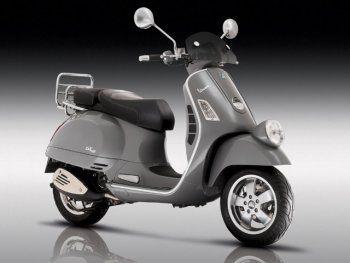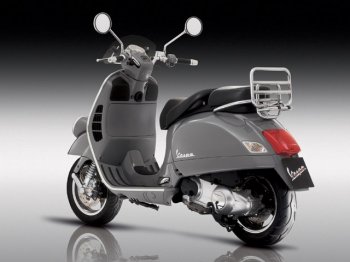|
The legendary
Italian scooter, the Vespa, celebrated its 60th birthday on
Thursday with a big party and unveiling of three new models,
reports ANSA. The event at Vespa's headquarters also
saw the presentation of a project to build a new Vespa
Museum, designed by famed architect Massimiliano Fuksas. The
Vespa's actual birthday was April 23, the day in 1946 when
the patent for the innovative two-wheeler was registered in
Florence by Piaggio & Co.
The scooter was the first step in the reconversion of an
airplane factory built here in 1917 and modelled on the one
Rinaldo Piaggio originally set up in the northwest coastal
region of Liguria in 1884. This first plant produced naval
furnishings and then branched out into the construction of
carriages, railway cars, trolleys, motors and chassis, for
the budding automobile industry.
Piaggio's shift to aircraft construction coincided with the
outbreak of World War I and the building of new plants,
including the one here between Pisa and Florence. The
Pontedera factory specialised in the production of the
four-engine P108 plane, both the passenger and bomber
models. During World War II Piaggio's factors in Genoa,
Finale Ligure and Pontedera were all bombed. The idea of
converting the airplane factory to civilian use was the
brainchild of Enrico Piaggio, a direct descendant of the
company's founder, while the innovative design was the work
of Corradino D'Ascanio.
An aircraft designer by trade, D'Ascanio came up with the
idea of producing a cheap, small-engine bike with its gear
shift on the handlebar and the motor over the back wheel.
This was then covered in a steel cowling which gave the
scooter its distinctive shape that made it look like a wasp,
which in Italian is vespa. Thanks to its protective front
shield and mud guard on the floor, the Vespa kept the rider
cleaner and drier than on a traditional motorbike. The
scooter was an immediate success, acting as the prototype
for all scooters to follow.
By 1949, over 35,000 scooters were produced and by the
mid-1950s Piaggio was producing the Vespa in Britain,
Germany, France, Belgium, Spain, Indonesia and India. In
Britain the Vespa became a cultural icon and in the early
1960s it was the preferred transportation for the young
people who defined themselves as 'Mods', compared to the
'Rockers' who rode motorcycles. This period was captured in
the 1979 British cult film Quadrophenia. The Vespa's most
famous movie cameo was in the 1953 film Roman Holiday, in
which journalist Gregory Peck gives princess-in-disguise
Audrey Hepburn a tour of the Italian capital on the back of
his Vespa.
After losing ground to Japanese competitors, the Vespa has
made a major comeback over the past five years or more
thanks to the introduction of new models which are easier to
drive and are more environmentally friendly. This reopened
the door to the lucrative United States market, where they
had been banned since the 1980s because of their poor
emissions ratings. Over 120 different Vespa models have been
produced since 1946 and more than 16 million scooters have
been sold.
As the Vespa turns 60, Piaggio
has presented two new models: the Vespa GT-60 and Vespa LX-60. Through a clever
re-interpretation of some of the typical design and technical elements of the
past, particularly the 1950s and 1960s, these bikes evoke the romance of the past in timeless Vespa fashion. The Vespa GT-60 and Vespa LX-60 are a tribute to this legendary
product, the result of purely Italian creativity and design.
Vespa GT-60
Developed on the base of the Vespa GTS 250, the GT-60 pays homage to the very
first scooter, the 1946 Vespa. The latest step in the Vespa's evolution, the 140th Vespa model - the GTS
250 i.e. - offers the perfect base for this design exercise.
|
 |
|
Developed on the base of the 2005 Vespa LX, the LX-60 has been conceived as a
tribute to the 1960s Vespas. The 1960s: a legendary decade that witnessed the social and cultural
revolution that shaped contemporary society, marked by the emergence of youth
for whom the Vespa symbolised individual mobility and freedom. |
|
|

 |
|
Developed on the base of the Vespa GTS 250, the GT-60 pays homage to the very
first scooter, the 1946 Vespa. The latest step in the Vespa's evolution, the 140th Vespa model - the GTS 250
i.e. - offers the perfect base for this design exercise. The Vespa's fundamental
strong point, an all-metal chassis, has been left untouched. The changes concern
all the details that have been modified over the years to keep up with
technological and design trends in various periods. |
|
|
The Vespa's fundamental
strong point, an all-metal chassis, has been left untouched. The changes concern
all the details that have been modified over the years to keep up with
technological and design trends in various periods.
On the very first prototype in 1946 the headlamp was positioned on the front
mudguard, moving to the handlebar in the mid-1950s. By placing the headlamp on
the front mudguard once again, the Vespa GT-60 makes a clear reference to the
origins of the Vespa, while the size and the lamp surface are suited to the
modern styling of the Vespa GTS. A similar change has been made to the handlebar, a simple, visible metal tube
on the very first Vespa prototype. This typically motorcycle/cycle feature could
be seen on each early Vespa series. The GT-60 also uses a 'naked' handlebar, but
one of modern motorcycle inspiration. The round analogue speedometer-mileometer has relatively retro graphics, plus
an up-to-date ride information display and electrical system.
The saddle has been comprehensively redesigned. The Vespa started out as a
single-seater that could be changed into a two-seater and remained this way for
quite some time. On the GT-60 the saddle goes back to being split into two
distinct parts, one for the rider and one for the passenger. Upholstered in
leather with stylish stitching, it emphasises the skill of Italian leather
craftsmen. The paint on the vehicle also recalls the Vespa's unique history. Like all
the early Vespa prototypes, painted an aeronautic grey, the GT-60 is grey,
albeit a warm, modern shade of iridescent metallic grey to flatter the design of
its all-metal body.
Vespa LX-60
Developed on the base of the 2005 Vespa LX, the LX-60 has been conceived as a
tribute to the 1960s Vespas. The 1960s: a legendary decade that witnessed the social and cultural
revolution that shaped contemporary society, marked by the emergence of youth
for whom the Vespa symbolised individual mobility and freedom. As on the Vespa GT-60, the changes concern the accessory parts to the metal
body, recently renewed on the LX series.
The headlamp remains in its original position on the handlebar, like the
1960s scooters from which the Vespa LX-60 is derived, but in a slimmer, more
minimalist version to emphasise the unfaired handlebar and make the front of the
vehicle a more lightweight look. The analogue instrumentation is placed in a chrome-plated frame while the
unique graphics resemble those in vogue in the 1960s. The 'naked' handlebar is a metal tube ending in fine leather handles, also
used on the saddle that separates the rider and passenger seats as on the early
models.
Reports: ANSA & Vespa
|
|
|
|
![]()
![]()